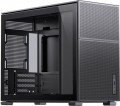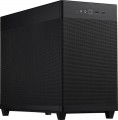Features
The direction in which the body is facing. This parameter is indicated only for models that have a certain specialization and differ markedly from general-purpose cases.
—
Gaming. Cases designed for high-performance gaming computer systems. They usually have numerous openings for expansion slots and bays for drives (see the corresponding paragraphs), as well as advanced options for installing cooling systems — many “seats” for fans, the ability to use liquid cooling (see “Liquid cooling support”) and etc. In addition, they often stand out due to their design: they can be equipped with decorative lighting, transparent windows, etc.
—
HTPC. Enclosures for PC multimedia orientation, the so-called Home Theater Personal Computer (HTPC). The characteristic features of such cases are compact size, the presence of additional buttons on the front panel for controlling multimedia (and sometimes a sensor for the remote control) and an advanced design.
Form factor
The form factor determines, first of all, the internal volume of the case (as a result, the motherboard used for it, see "Type of motherboard"), as well as installation features. To date, PC cases are available in the following main form factors:
—
Full Tower. The tower case is one of the largest form factors for PCs today: 15-20 cm wide, 50-60 cm high, with up to 10 externally accessible bays. Most often in this form factor running advanced high performance PCs.
—
Ultra Tower. Further development and expansion of Full Tower cases (see above), offering even more space for hardware: the width of such a case is about 25 cm, the height can reach 70 cm, which allows you to install powerful configurations inside and provides enough free space for effective cooling .
—
Midi Tower. A representative of the tower family (tower cases) of medium size — about 45 cm in height with a width of 15-20 cm, with the number of external bays from 2 to 4. Most popular for middle-class home PCs.
—
Mini Tower. The most compact "vertical" case type, with a width of 15-20 cm, has a height of about 35 cm and (usually) less than 2 compartments with external access. It is mainly used for assembling office PCs that do not require high performance.
—
Desktop. Enclosures designed for i
...nstallation directly on the desktop. They often have the possibility of horizontal installation — in such a way that a monitor can be placed on top of the case — although there are also models that are installed strictly vertically. The size of such cases can be almost anything — from miniature solutions for thin mini ITX motherboards to large-sized cases for E-ATX (see "Motherboard type"). However, most "desktops" are relatively small.
— Cube Case. Cases having a cubic or close to it shape. They can have different sizes and are intended for different types of motherboards, this point in each case should be clarified separately. Anyway, such cases have a rather original appearance, different from traditional "towers" and "desktops".
— Dual Tower. Quite a rare option — cases, in size and proportions resembling two "towers", made up side by side. Dual Tower solutions are large in size and are intended mainly for powerful high-performance PCs (in particular, top gaming stations).
Note that there are models that allow both vertical and horizontal installation and can, in fact, turn from a "tower" to a "desktop" and vice versa. For such cases, the form factor is indicated by the form factor named in the manufacturer's documentation, or by the main installation method described there.PSU max lenght
Possible length of the PSU that can be installed in the case.
Graphics card max lenght
The maximum length of a graphics card that can be installed in this case.
Modern mid-range and top-end video cards with high performance often differ in considerable length, which is why such a card can not fit into any case. So before collecting components, it is worth evaluating the length of the proposed graphics card and choosing a case in which it is guaranteed to fit. This forethought is useful anyway, but it's especially true if you're building a system that requires a powerful graphics adapter, such as a high-end gaming PC or 3D design workstation.
Fan max height
The highest cooler height allowed for this case.
In this case, we mean a cooler used to cool the processor — such a component is found in the vast majority of modern PCs. Height is measured relative to the motherboard.
Sidewall thickness
The thickness of the side walls used in the case. When choosing a thickness, manufacturers have to compromise between several points at once. On the one hand, thin walls are inexpensive and heat dissipates faster through them, which has a positive effect on cooling efficiency. On the other hand, powerful systems inevitably require thick walls, otherwise the case may simply not withstand the weight of advanced high-performance components. Thirdly, steel is a fairly durable material even with a relatively small thickness. In light of all this, in most models this indicator does not exceed
0.7 —
0.8 mm, and more often it is about
0.5 –
0.6 mm.
3.5" bays
The number of internal 3.5" form factor bays provided in the design of the case. Such bays, in accordance with the name, are intended for internal components, mainly hard drives and some SSD modules; to access them, the case must be disassembled.
Theoretically, the number of bays corresponds to the maximum number of drives that can be installed in the chassis. However, in fact, the best option is to install drives through a single slot to ensure efficient cooling. Accordingly, it is best to select a case in such a way that the number of internal 3.5" bays is twice the expected number of hard drives.
internal 2.5" compartments
The number
of internal 2.5" bays provided in the case design.
Such bays are mainly used for installing internal hard drives and SSD modules; The 2.5" form factor was originally created as "laptop" form factor, but recently it has been increasingly used in components for full-size PCs. At the same time, when evaluating the number of these bays, note that drives are recommended to be installed through a slot; so in Ideally, the number of bays should be twice the planned number of drives.
Also note that some cases use combined bays: initially they have a size of 3.5", but if desired, they can be converted to 2.5". These bays count towards both 3.5-inch and 2.5-inch slots. In fact, this means that the total number of available slots is not always equal to the sum of the number of both. For example, a case with 10 3.5" bays and 6 2.5" bays can have 4 combined bays, and the total number of slots in this case will not be 16, but only 12.
Fans total
The
more fans provided in the design, other things being equal, the more intense the cooling will be and the more powerful (and, accordingly, “hot”) hardware can be placed in the case without the risk of overheating. For everyday tasks, a case with
one,
two or
three factory fans is enough. At the same time, when comparing, it is worth considering not only the number, but also the performance characteristics of the fans (diameter, speed). Also note that there are
cases without fans on the market with free space for fans, which allows, if necessary, to supplement the cooling system and improve its performance.

